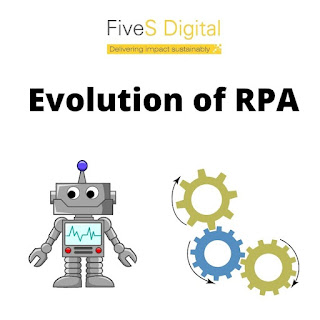Evolution of RPA - FiveS Digital
Robotic Process Automation is one of the most
important developments in Business Process Management (BPM) in recent times.
According to some industry experts, it may prove to be more transformative than
cloud computing.
In recent times, Robotic Process Automation has been one of
the most important developments in Business Process Management (BPM). According
to some industry experts, it may prove to be more transformative than cloud
computing.
However, is this revolutionary technology new? Anyone who is
a BPM practitioner and has a good understanding of history will know that RPATechnology has existed for many years. Inbound call centers have used
Interactive Voice Response Systems (IVRS) for many years. These systems use
robots to assist customers and accept voice-based or key tone responses. They
then pass instructions to the underlying software to complete a transaction.
The optical character recognition technology (OCR), also
known as software robots, has been used for some time to provide high
auto-extraction efficiency. Since the introduction of web-based solutions, the
industry has used internet bots (short for robots) to auto-post data. For many
years, the Software Testing industry used similar automation to post data into
applications in order to manage functional, user, and, more importantly,
regression testing.

The maturity of the technology and the business processes
that it is applied to is what makes the current wave of RPA services
different. RPA Technology is rapidly growing in popularity. Widespread
adoption of robotic automation could revolutionize the BPM market. I believe
that this transformation will be driven through five outcomes.
- Reduced
costs: Software robots typically cost at least one-third of an offshore
FTE.
- Efficiency:
RPA can operate 24X7 if the core applications are available.
- Accuracy:
Human FTEs can make mistakes in data entry, while robots do the same task
every time.
- Increased
audit and regulatory compliance: Robots can provide detailed audit logs,
which can be used to enable advanced business analytics and better
compliance.
- Easy
management of changes: Robots can leverage the existing application
presentation layer and re-use existing database logic, validation and
validation without deep understanding or re-engineering.
RPA Technology isn't new. Your organization and you
have been affected by robotic automation in some way or another. They say that
an idea that is ready to be implemented is the most powerful. The time is right
for RPA-powered transformation.
The evolution of RPA-Technology over time:
Let's break it down into four phases.
1.Assisted ROPA (Probots).
The digital bots known as Probots, or Bots, are digital
robots that perform repetitive tasks for employees. These bots have been in use
since the beginning of technology. It was called Robotic Process Automation
at the time and not cognitive. These were automation programs that were able to
perform a set of predefined tasks without human intervention. They used
different methods and methodologies like screen scraping (fetching information
from the screen) etc.
Assistive RPA's goal was to improve worker productivity. They were installed on the worker's computer. They were not fully automated and therefore difficult to scale up.
2.Unassisted RPA (Knowbots)
The RPA software can be deployed on multiple machines or on a server. This type of automation can be processed without the need for human intervention. It is capable of triggering the process, monitoring the progress, and closing it when it is completed. You don't even need to be present for the automation. These steps can all be automated using dashboards that allow users to assign tasks, change priorities and create queues.
3.Autonomous RPA
Autonomous RPA software utilizes new technologies
such as Artificial Intelligence and Cognitive Automation, Machine Learning,
Computer Vision, and Robotic Process Automation.
Because of their unique features (auto scaling, dynamic load balance, awareness of context, advanced analytics, etc.), autonomous RPA software can be deployed on the cloud. They still faced a significant limitation: the inability to process unstructured data. This was the catalyst for the development of the next level in RPA technology.
4. Cognitive RPA(Chatbots)
These bots are those that specialize in different areas of work. As their name suggests, Chatbots can communicate with customers, clients, and other stakeholders in any business. They also share information intelligently and convey the information as requested. These bots generally have NLP, which allows them to process natural human language.
Conclusion
Cognitive RPA technology can process unstructured data. It is capable of performing perspective and predictive analysis. It can dynamically balance workloads and automate tasks that require judgment and decision-making.


Comments
Post a Comment